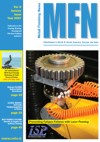E-Archive
Articles
in Vol. 8 - January Issue - Year 2007
Vapormatt's International Demonstration Vehicle Brings The Benefits of Wet Blasting to Your Door

Interior of the International Demonstration Vehicle

Wet blast surface treatment specialist Vapormatt, has completely upgraded and re-equipped the company’s International Demonstration Vehicle (IDV) which, over the past few years, has travelled widely throughout Britain and continental Europe to demonstrate the benefits of wet blasting for a wide variety of surface cleaning, degreasing, finishing and treatment applications. These include the surface preparation of composite materials prior to bonding, heat scale removal from aluminium extrusion dies, the refurbishment of automotive parts and the cleaning of aircraft wheels.
The IDV – repainted in Vapormatt’s new corporate livery – is now ready to take to the road again, giving companies the opportunity to arrange a visit to their own premises to view wet blast technology in action and have the opportunity to process their own sample components.
The spacious interior of the 7-metre long self-contained vehicle features three fully operational wet blast machines: a 'Vapormate 1', a 'Panther 3' and a 'Lynx 10', which have processing enclosure sizes of 700mm x 700mm x 700mm, 995mm x 700mm x 700m, and 950mm x 950mm x 1350mm, respectively. These three manually operated machines embrace wet blast applications ranging from workshop or garage small parts cleaning and degreasing to full production surface treatments such as cosmetic finishing and wet peening.
There is also a comfortable seating area, a DVD player to show installed machines in-production in different areas of manufacturing, a computer link to Vapormatt’s informative website – www.vapormatt.com – and on-board coffee and tea making facilities.
More on the wet blast process
The Vapormatt wet blast process utilises water and fine abrasives in suspension, delivered by a slurry pump and accelerated by compressed air to the process nozzle, which is normally manually operated – automatic nozzle manipulation and component rotation are also available for repetitive tasks. The action of the slurry scours the surface to create a thoroughly clean, lightly abraded result. To provide simultaneous cleaning and degreasing, the water can be heated and mild detergent added to ensure the effective removal of oily surface contamination. Unlike dry blasting, no potentially harmful dust is produced.
The ratio between the water pressure and air pressure in the process nozzle is variable, to enable a "water buffer" to be maintained between the abrasive media and the surface being processed. This water buffer effect has a number of major benefits. It lubricates the action of the media, eliminates static build-up – important when processing composite or plastic materials – and washes the surface continuously during processing.
No solvents or other potentially hazardous chemicals are used by the wet blast process, so it is not subject to stringent EU solvent emission, VOC or dust emission legislation.
Further information:
Robin Ashworth
Vapormatt Ltd, Monarch Centre,
Venture Way, Priorswood Industrial Estate, Taunton, Somerset, TA2 8DE, UK.
Tel. +44.1823.257976, Fax: +44.1823-336446
E-mail: robin.ashworth@vapormatt.com
www.vapormatt.com




























